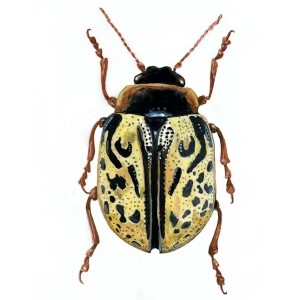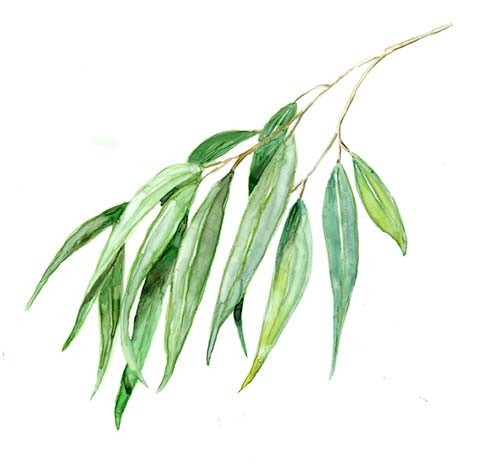
While I was searching the drawers of the Saint Michael’s College insect collection, a spectacular little beetle caught my eye. The pearlescent elytra, or wing coverings, were marked with the unmistakable, stark black stripes and dots of a calligrapher beetle. As their name suggests, these small, shiny beetles look as if a skilled hand drew black cursive on their backs. The contrast between the color of their elytra and black markings gives the impression of filigree on fine jewelry.
The genus Calligrapha is part of the large family of leaf and seed beetles (Crysomelidae), insects that specialize on particular plants. There are 38 North American species in the genus, including at least 20 in the Northeast. Some of my favorites include the Calligrapha multipunctata, the common willow calligrapher, and the particularly striking ninebark calligraphy beetle (Calligrapha spiraeae), whose black-marked red carapaces graced my research field site in Pennsylvania.
In addition to their good looks, calligrapher beetles are special for the way that some species reproduce. While most Calligrapha species follow the typical “boy meets girl” pattern, at least seven species have dispensed entirely with boys. Instead, when the season is right and other species are busy with courtship rituals, the females simply lay eggs on their favored host plants. You could call it “virgin birth,” but biologists use the term “parthenogenesis.” The eggs hatch and produce near-perfect clones of their mothers.
A common definition for a species is a population of individuals capable of interbreeding. So how can biologists confidently declare that there are seven all-female species in one genus? In this case, biologists rely on morphological distinctness, as one would with fossil species, and genetic differences used to define species in bacteria and other asexual organisms.
Subtle genetic differences between generations of mothers and daughters are also used to determine the age of these species. Because mutations happen at predictable rates, Jesús Gómez-Zurita from London’s Natural History Museum and collaborators inferred that these all-female beetles originated more than 11,000 years ago during the Pleistocene due to hybridization between related beetles. One such species, C. suturella, arose due to hybridization between the willow calligrapher beetle and a dogwood calligrapher beetle (C. philadelphica).
The willow calligrapher is the most commonly encountered of the genus. It varies from a creamy tan-bronze to near silver-gray and has the black markings typical of the genus. The species name multipunctata refers to multiple spots, holes, or perforations. It might seem that this refers to the obvious spots on the beetles’ back. But closer examination with a hand lens or microscope reveals tiny holes or pores in the elytra, many of them lining up with the borders of the markings. It is as though black ink was dripped on the beetle and spread until the row of pores halted its progress.
As the common name suggests, these 3/8-inch beetles are fond of willow species. Both adults and larvae feed on leaves, but rarely at densities that cause significant tree damage. Willow calligrapher larvae hatch in May from lemon-yellow eggs measuring less than 1/16 of an inch and set to work eating willow leaves just a few hours later. They feed and grow for about three weeks before abandoning their willow tree to pupate in the soil. The adults emerge three weeks later and continue to feed on willows before overwintering in the soil near their host trees. You can expect to find adults emerging and mating the following spring.
Finding live specimens of these beetles is more challenging than locating them lined up in formation in a museum drawer. And searching through willow branches is not the best approach. When disturbed, the beetles just let go and bounce like pinballs through the branches into the undergrowth, where they are next to impossible to find. A better tactic is to take advantage of this falling behavior by placing something underneath to intercept them on the way down.
Entomologists use “beating trays” that resemble square white fabric kites stretched over two intersecting sticks attached to the corners of the fabric. An old shower curtain or bed sheet will also do the trick. Simply place it under a willow and give the branches a good shake. Gather up the corners and in the middle, you’ll find the catch of the day.
Native willows, including black willow that grows on the Saint Michael’s College campus, are some of the best host trees for caterpillars throughout New England. According to the National Wildlife Federation, in my locality in northern Vermont, more than 400 moth and butterfly species deposit their eggs on willows. So even if you fail to locate calligrapher beetles, it is likely that your efforts will be rewarded with something interesting.



Discussion *